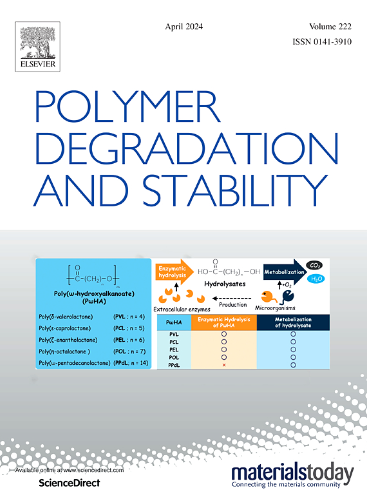Volatile compounds characterization of microalgae biomass (Chlorella sp. HS2) at high processing temperatures for application to an eco-friendly polymer composite
IF 6.3
2区 化学
Q1 POLYMER SCIENCE
引用次数: 0
Abstract
In this study, we investigate the volatile organic compounds release characteristics of microalgae (Chlorella sp. HS2) in relation to temperature in an effort to realize an alternative type of biomass for use in the fabrication of eco-friendly polymer composites. The volatile organic compounds (VOCs) generated during the compounding process of the polymer composite is quantified and the VOC generation pathways are discussed. As the microalgae are heated and their content in the composites increases, the intensity of the VOC release increases. At a high temperature of 180 °C, a typical polymer processing temperature, microalgae release volatile substances. The VOCs are identified as compounds containing ketone functional groups and benzene derivatives through chromatography and spectrometry analyses. VOCs with ketone functional group can originate from small fatty acids by a complex reaction pathway that includes hydrolysis, oxidation, and degradation, while benzene derivatives are from aromatic amino acids, such as Tyrosine, Phenylalanine, and Tryptophan, contained in the microalgae. The findings demonstrate that microalgae biomass particles produce VOCs during polymer processing, which must be considered during the fabrication and eventual commercialization of polymer composites.
微藻生物质(小球藻sp. HS2)在高温下挥发性化合物的表征及其应用于环保聚合物复合材料
在这项研究中,我们研究了微藻(小球藻sp. HS2)挥发性有机化合物释放特性与温度的关系,以实现一种可用于制造环保聚合物复合材料的替代生物质。对聚合物复合材料在复合过程中产生的挥发性有机化合物(VOC)进行了定量分析,并对VOC的产生途径进行了讨论。随着微藻的升温,复合材料中微藻含量的增加,VOC的释放强度也随之增加。在高温180℃,典型的聚合物加工温度下,微藻释放出挥发性物质。通过色谱和光谱分析,确定了VOCs为含有酮类官能团和苯衍生物的化合物。具有酮类官能团的VOCs可以通过水解、氧化和降解等复杂反应途径来源于小脂肪酸,而苯衍生物则来源于微藻中含有的芳香氨基酸,如酪氨酸、苯丙氨酸和色氨酸。研究结果表明,微藻生物质颗粒在聚合物加工过程中产生挥发性有机化合物,这是聚合物复合材料制造和最终商业化过程中必须考虑的问题。
本文章由计算机程序翻译,如有差异,请以英文原文为准。
求助全文
约1分钟内获得全文
求助全文
来源期刊

Polymer Degradation and Stability
化学-高分子科学
CiteScore
10.10
自引率
10.20%
发文量
325
审稿时长
23 days
期刊介绍:
Polymer Degradation and Stability deals with the degradation reactions and their control which are a major preoccupation of practitioners of the many and diverse aspects of modern polymer technology.
Deteriorative reactions occur during processing, when polymers are subjected to heat, oxygen and mechanical stress, and during the useful life of the materials when oxygen and sunlight are the most important degradative agencies. In more specialised applications, degradation may be induced by high energy radiation, ozone, atmospheric pollutants, mechanical stress, biological action, hydrolysis and many other influences. The mechanisms of these reactions and stabilisation processes must be understood if the technology and application of polymers are to continue to advance. The reporting of investigations of this kind is therefore a major function of this journal.
However there are also new developments in polymer technology in which degradation processes find positive applications. For example, photodegradable plastics are now available, the recycling of polymeric products will become increasingly important, degradation and combustion studies are involved in the definition of the fire hazards which are associated with polymeric materials and the microelectronics industry is vitally dependent upon polymer degradation in the manufacture of its circuitry. Polymer properties may also be improved by processes like curing and grafting, the chemistry of which can be closely related to that which causes physical deterioration in other circumstances.
 求助内容:
求助内容: 应助结果提醒方式:
应助结果提醒方式:


